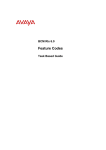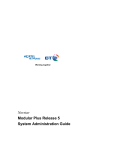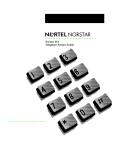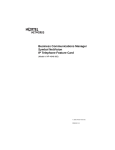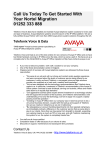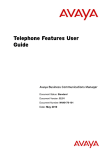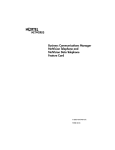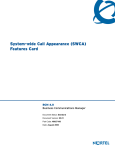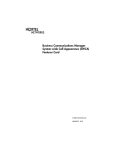Download Avaya Telephone Feature User Guide
Transcript
Business Communications Manager Telephone Feature User Guide © 2004 Nortel Networks N0008599 01 March 8, 2005 Telephone button icons Use this guide as a quick reference for accessing the features of your telephone. Your system administrator will inform you if any of these features are not available for your telephone. The Digital phones Feature button is a small globe icon. Other telephones have different icons, or they display Feature above a display key, when feature selection is available. This book uses FEATURE to indicate pressing the Feature key before entering a feature code. The table below shows which buttons to use on the different types of Nortel Networks telephones to use the features. Refer to each user card for specific details about each type of telephone. Button Function Digital phones/ Digital Mobility phones Legacy telephones Feature Release On/Offhook Answer call Display key , , , , ≥ Hold IP telephones , Telephones with line buttons: Press the active line button or Intercom key and lift handset. Telephones with no buttons: Lift handset. In this guide: This guide uses the following labels to indicate each type of configuration button: • FEATURE indicates pressing the Feature key • HOLD indicates pressing the Hold key (or equivalent) • RLS indicates pressing the Release key (or equivalent) The following symbols are used to indicate different types of phones. Within the text they indicate features that are not supported or which require different actions than the standard digital phones: * = 7000 and 7100 Digital phones and the 2001 IP telephone ^ = Digital Mobility phones + = WLAN IP phones See the handset user cards for descriptions of handset button icons and user menus for the Digital Mobility and WLAN IP phones. Note: Your telephone may not have access to all the features listed in this guide. This may be because your telephone does not support the feature, or because the feature has not been enabled at your telephone. Your system administrator can provide details. Page 3 Telephone features Background Music ^+ (not avail.) Button Inquiry FEATURE 86 Cancel: FEATURE #86 Listen to music (provided by an external source or an IP source connected to the system) through your telephone speaker when you are not on a call. *^+ (shows DN) FEATURE *0 Check what is programmed on any button. Use when labeling buttons. Call Duration Timer FEATURE 77 Briefly display the approximate length of your current or most recent call. Call Forward FEATURE 4 Cancel: FEATURE #4 Send your calls to another telephone in your system. Call park FEATURE 74 Put a call on hold so that it can be picked up from any telephone in your system. The display shows a three-digit retrieval code. To retrieve a parked call: press an intercom button and dial the retrieval code. *^ (Lift the handset/go off-hook and dial the retrieval code). Call Pickup, directed FEATURE 76 and the telephone number Answer any ringing telephone. Call Pickup, group FEATURE 75 Answer a call that is ringing at another telephone in your pickup group. The external call that has been ringing longest is answered first. Call Queuing FEATURE 801 Answer the next call. If more than one call is waiting, priority is given to incoming external calls over callback, camped, or transferred calls. Camp-on FEATURE 82 and the extension number of the receiving telephone Re-route a call to another telephone even if all its lines are busy. Class of service FEATURE 68 plus COS password password Change the dialing filters on a line or telephone, or gain external access to your system. Dialing filters determine which numbers you can dial. The COS password is provided by your System Administrator to change your class of service. Page 4 Telephone features Conference FEATURE 3 *^(Step 5 not required) Establish a conference call between yourself and two other parties. 1. 2. 3. 4. 5. 6. Make or answer the first call. Put the first call on hold. Make or answer the second call. After the second call is connected, press FEATURE 3. Press the line or intercom button of the first held call. Press RLS to end the conference call. To remove yourself from a conference permanently (unsupervised conference): Press FEATURE 70. The other two callers remain connected. (Some external lines may not support this feature.) To put a conference on hold: Press HOLD. The other two callers can still talk to each other. To split a conference: Press the line or intercom button of one caller to consult privately while the other caller is on hold. To re-establish the conference: Press FEATURE 3. To disconnect one party: 1. Press the line or intercom button for the caller you want to disconnect. 2. Press RLS. 3. Press the line or intercom button for the remaining caller to resume your conversation. To independently hold two calls: 1. Press the line or intercom button of the first caller. 2. Press HOLD. The second caller is automatically put on hold. To re-establish the conference: 1. Retrieve one call from hold. 2. Press FEATURE 3. 3. Retrieve the second call from hold. Page 5 Telephone features To send Hookswitch or DTMF during a conference call Either system telephone engaged in a three-way conference call over a Network CLID or DS trunk can issue a hookswitch or DTMF dialing request without leaving the conference, if the feature is enabled. Note: This feature is not available for 20xx IP telephones or Symbol NetVision handsets. – To hear DTMF tones on both telephones during dial, activate Long Tones (FEATURE 808). – To conference in someone through the trunk, use Link (FEATURE 71) Contrast adjustment FEATURE *7 plus a number from 1 to 9 to adjust the display contrast. Press HOLD to set your choice. ^+ (set-based) Dialing modes ^+ (set based) FEATURE *82 Choose one of three methods of dialing. 1. Press FEATURE *82. 2. Press # to select the mode. 3. Press HOLD to store the mode. Standard Dial: Select a line, then dial the number. (Standard Dial is always available, even when another dialing mode is selected.) Automatic Dial: Dial the number without choosing a line button first. Your prime line is automatically selected for the call. Pre-Dial: Dial the number, then press a line button to place the call. Edit the number by pressing the volume bar before placing the call. Do Not Disturb FEATURE 85 Cancel: FEATURE #85 When you are not on a call prevent all incoming calls, except priority calls, from ringing at your telephone. When you are on a call, block an incoming priority call. Group Listening FEATURE 802 Cancel: FEATURE #802 Use both the handset and speaker while you are on a call. To avoid electronic feedback, keep the handset away from the speaker during the call, and press RLS to hang up. Note: Most of the portable handsets do not have speakers, so cannot use this feature. *^+ (not avail.) Page 6 Telephone features Handsfree *^+ (not avail.) Handsfree/mute or Handsfree button Press the key to transfer a call from the handset/headset to the telephone speaker. If you picked up the handset, return it to the cradle. Note: Handsfree speaker volume returns to the default volume set at the telephone at the end of each call. Hold Press HOLD Temporarily suspend a call. To retrieve a held call, press the line button for the held call. *^+ (Press HOLD to toggle between two calls.) Hold Exclusive FEATURE 79 or FEATURE/HOLD Temporarily suspend a call and prevent other telephones from picking it up. Hold - Auto FEATURE 73 Cancel: FEATURE #73 Set your telephone to automatically put a call on Hold when you pick up a second call, or stop your telephone from doing so. Default is Yes (feature is on). Note: Telephones which have system-wide call appearance buttons (SWCA) must have this feature active (set to Yes). Language choice FEATURE *501: Select Primary Language for the telephone display. FEATURE *502: Select Alternate Language for the telephone display. FEATURE *503: Select Alternate Language 2 for the telephone display. FEATURE *504: Select Alternate Language 3 for the telephone display. ^+ This feature sets only the system-based prompts for these telephones. Use the handset menu to set the set-based prompts. Last Number Redial FEATURE 5 Automatically redial the last external telephone number that you dialed. Line pools FEATURE 64 With a line pool, telephones can share several lines for making calls. 1. Press FEATURE 64 or an intercom button. 2. Enter a line pool access code. (See your System Administrator for a list.) * (no intercom buttons) ^ (hook key = intercom button press) Page 7 Telephone features Line redirection *^+ (not avail.) FEATURE 84 Cancel: FEATURE #84 Send calls arriving on an external line to another telephone outside your system. (Some external lines may not support this feature. See your System Administrator.) Link FEATURE 71 Generate a Link signal to access a PBX or other host exchange. Long tones FEATURE 808 Generate a tone for as long as you hold down a button. This is used to communicate with devices like fax or answering machines. Long tones are in effect only for your current call. ^ (static three-second tone per button press) Messages FEATURE 1 Cancel: FEATURE #1 Send a message to another telephone within your system. To view and reply to your messages: 1. Press FEATURE 65. 2. Press * and # to view your message list. 3. Press 0 to call the person who left you the message. To erase a message: Press HOLD while viewing a message. Moving line buttons *^+ (not avail.) Page 8 FEATURE *81 Change the position of your line or hunt group buttons. 1. Press FEATURE *81. 2. Press the line button that you want to move. 3. Press the button that you want to move the line to. 4. Press RLS. The two buttons are exchanged. 5. Update the button label strip on your telephone. Line buttons cannot be exchanged with intercom, answer DN or handsfree buttons. Telephone features Moving line buttons (WLAN handsets only) Change the position of Lines assigned to the handset Line menu. 1. Press FEATURE *82. 2. Press the Line key. 3. Press the key corresponding to the Line menu item that you want to move. 4. Press the Line key. 5. Press the key corresponding to the Line menu position where you want the line to move. Line buttons cannot be exchanged with intercom, answer DN or Handsfree buttons. Mute Handsfree/mute or Mute button Press this button when you do not want the caller to hear anything from your side of a handsfree call. The display light beside the button blinks when the call is muted. The mute button on the T-series and i-series telephones mutes all types of calls. Page announcement note: A call retrieved from hold after a page announcement does not necessarily remain muted. *^+ (not avail. or set-based) Name and number block FEATURE 819 Block the outgoing name and/or number for a specific call. Page FEATURE 60 and code (1 to 3) and zone (0 to 6) Make a page announcement through either the internal (code 1) or external (code 2) speakers, or both (code 3). Zone 0 pages all zones. Page announcements are programmed to timeout after a pre-selected amount of time which is set by your System Administrator. *^+ (cannot receive pages) Internal page FEATURE 61 and zone (0 to 6) Make a page announcement to all, or to a specific group of telephones, through the telephone speakers. Zone 0 pages all zones. External page FEATURE 62 Make a page announcement through an external loudspeaker system. Page 9 Telephone features Internal and external page FEATURE 63 and zone (0 to 6) Make a page announcement through both your telephone speakers and an external loudspeaker system. Zone 0 pages all zones. Incoming page during active call: The system can be set to either: • Put an active call on hold, and broadcast the incoming page. • Archive the page until you hang up from the call. This feature is set by your system administrator. Note: Business Series Terminals: a call on mute when the page comes in, will not remain muted when it is released from hold after the page. Pause FEATURE 78 Program in an external autodial sequence to insert a 1.5-second delay. For pulse dialing: * also inserts a 1.5-second delay. Priority call FEATURE 69 Interrupt a person who is on a call. A person on another call can press FEATURE 85 (Do Not Disturb) to block priority calls. *(ringing call) ^ (incoming blocked) Privacy FEATURE 83 Change the privacy setting for an external line. If a line normally has privacy, this permits another telephone that shares the line to join your call by selecting the line while you are using it. If a line normally has privacy disabled, this prevents another telephone that shares the line from joining your call by selecting the line while you are using it. The privacy setting is re-established once you end your call or when you enter the Privacy feature code again. Ring again FEATURE 2 Cancel: FEATURE #2 Monitor a busy or unanswered telephone, or a busy line pool within your system. Ring Again signals you to call back when the telephone or line pool becomes available. Page 10 Telephone features Ring type ^+ (set-based) Ring volume ^+ (set-based) FEATURE *6 Select a distinctive ring to help differentiate between your telephone and others nearby. 1. Press FEATURE *6. 2. Enter the ring type number (1 to 4). 3. Press HOLD. FEATURE *80 Make your telephone ring so that you can adjust the volume. You can also adjust the volume any time your telephone rings. Run/stop FEATURE *9 Store more than one autodial number or external carrier feature code on one memory button by inserting a break point between numbers or codes. The first press of the button dials the first number or code; the next press dials the next number or code. You can program up to four numbers or codes separated by break points. Saved number redial FEATURE 67 Save a number to redial later. Enter the code while you are on a call that you have dialed to save the number. Enter the code when you are not on a call to redial the saved number. Service schedules FEATURE 870 Display the modes that have been turned on at a designated control set. Ringing services FEATURE 871 Cancel: FEATURE #871 Turn on one of six schedules for alternative ringing/call answering arrangements from a designated control telephone. Restriction services FEATURE 872 Cancel: FEATURE #872 Turn on one of six services for restrictions on particular lines or telephones from a designated control telephone. You will be required to enter a password. Routing services FEATURE 873 Cancel: FEATURE #873 Turn on one of six services for routing on particular lines or telephones from a designated control telephone. You will be required to enter a password. Page 11 Telephone features Speed dial using FEATURE 0 Dial an external telephone number using a two or three-digit code. There are two types of speed dial codes: system (01-70 or 001 to 255) and personal (71 to 94). System speed dial codes can be used from any display telephone in the system. They are assigned by your System Administrator. Personal speed dial codes are used exclusively at your telephone. To make a call using a speed dial code: 1. Press FEATURE 0. 2. Enter the two or three-digit code for the number. Speed dial programming To program personal speed dial numbers: 1. Press FEATURE *4. 2. Enter a two-digit code from 71 to 94. 3. Specify the external line by pressing a line button, a line pool button, or the intercom button. If you do not specify the external line, the system automatically chooses a line for the call. 4. Dial the telephone number you want to program (up to 24 digits). 5. Press HOLD. 6. Record the code and number you have just programmed. Note: You cannot program personal speed dial numbers while someone else is programming your system. Static time and date FEATURE 806 Cancel: FEATURE #806 Change the first line of the display to the current time and date. ^+ (Automatic change for Daylight Savings Time is not supported. SWCA keys FEATURE *521 to FEATURE *536 programmed to buttons with indicators or as non-appearance assignments. Refer to the SWCA user card for detailed instructions about parking and retrieving SWCA-associated calls. FEATURE *520 Find first available SWCA assignment on this telephone or repark call on a previously-assigned SWCA assignment. FEATURE *537 Find the oldest parked SWCA call on SWCA assignments for this telephone. FEATURE *538 Find the newest parked SWCA call on SWCA assignments for this telephone. Page 12 Telephone features Time FEATURE 803 Briefly display the time and date while you are on a call. Transfer FEATURE 70 Send a call to another telephone within your system, or to an external telephone. You may not be able to transfer a call on an external line to an external telephone, depending on the capabilities of the lines. Make or answer a call. 1. Press FEATURE 70. 2. Call the person you want to transfer the call to. 3. Stay on the line if you wish to speak to the person first. 4. Press RLS to complete the transfer. If an external call is transferred to a busy internal or network extension, or is not answered after a few rings, the call automatically rings you back. Trunk answer FEATURE 800 Answer an external call that is ringing on a line that has been placed into a Ringing Service schedule from any telephone in your system. This feature does not work for a private line. Voice call FEATURE 66 Make a voice announcement or begin a conversation through the speaker of another telephone without first making the other telephone ring. *^+ (ringing call) Voice call deny ^+ (not avail.) Wait for dial tone FEATURE 88 Cancel: FEATURE #88 Prevent your telephone from receiving voice calls. Do Not Disturb (FEATURE 85) also prevents your telephone from receiving voice calls. FEATURE 804 Program in an external autodial number to cause the system to wait to receive dial tone from another system before proceeding with the dialing sequence. Page 13 Call Display Services The following features are available only if you subscribe to Call Display services from your local telephone company. Autobumping FEATURE 815 Cancel: FEATURE #815 Have the system automatically delete the oldest log item from a full Call Log, so that a new log item can be stored. Call information FEATURE 811 Display the name, number or line name of a ringing or held call. Press # to move through the information displays. Call log view FEATURE 812 Call Log displays use the following special characters: • underline: identifies a new item • handset icon: identifies answered calls • globe icon: identifies long distance calls • forward slash: identifies that the information has been shortened + (cannot scroll through the menu) To view your Call Log: 1. Press FEATURE 812 2. Press * to view old items. Press # to view new items. Press 0 to return to the last viewed item. 3. Press # and * to move through your items. 4. Press the volume bar to view more information on an item. Call log erase entry To erase a Call Log entry: Call log return call To return a call from your Call Log: Call log options Page 14 1. Press HOLD while viewing an item. WLAN handsets: Use the TRIM soft key to delete each digit. 1. Display the desired number on your telephone. 2. Edit the number, if required. You can add numbers for long distance dialing or line pool access or remove numbers using the volume bar. 3. Press a line button. 4. Lift the handset. FEATURE *84 Select the type of calls that will automatically be stored in your Call Log. Press # to see the next setting. Press HOLD to select the displayed setting. Call Display Services Call log password FEATURE *85 Program a four-digit password for your Call Log. To remove a forgotten password, see your System Administrator. Logit FEATURE 813 Store caller information for your current call in your Call Log. ETSI feature MCID FEATURE 897 must be entered 30 seconds after the caller hangs up, and (ETSI feature) before you hang up Record caller information for last external call at the central office that assigned the line. This feature only works if the incoming calls were received over ETSI ISDN lines, and the feature is activated in programming. Check with your system administrator. Page 15 IP telephone features for 20XX telephones Feature menus FEATURE *900 or (services key access Feature menu) + (cannot scroll through menu) 1. Press Page+ (move forward) and Page- (move back) to scroll through the list. You can also use the up and down navigation keys on the telephone. 2. When the feature you want is highlighted, press Select. From this point, the feature works in the same manner as it does when invoked from the keypad or through the memory buttons. Note: The available features on this menu are configured by your system administrator. Hot desking setting up FEATURE *999 or (services key to access Feature menu) You can divert your Nortel IP telephone configuration to another Nortel IP telephone registered on the same system, using the Hot Desking feature. For instance, this feature can be used if you are temporarily working at another site, but you want to retain your telephone set up. Note: The headset mode does not get transferred during Hot desking. Activate a display menu of feature options. Setting up hot desking 1. Ensure both telephones are on-hook. 2. On your telephone (xxx), enter Hot desking. 3. Press Admin. The first time you do this, the display reads Creating password. The next time you enter hot desking, the display reads Enter password. 4. Use the dial pad to enter a password. Note: Use the Back key to erase entries. 5. Press OK. The first time you do this, the display reads Confirm password. Continue with step 5. The next time you enter hot desking, the display reads either Disallow hot desking or Allow hot desking, skip to step 7. 6. Use the dial pad to enter the same password you entered in step 3. 7. Press OK to save the password. The display reads Disallow hot desking. 8. If you want to allow/disallow hot desking, press CHANGE to select the function you require. 9. Press Quit to exit. Page 16 IP telephone features for 20XX telephones Hot desking activating Hot desking cancelling To activate hot desking: On the telephone to which you are diverting your calls (yyy). 1. Enter Hot desking: 2. Press Divert. 3. At the DN prompt, enter the DN of your telephone (xxx). 4. Press OK. The display reads Enter < > PW. 5. Enter the password for your telephone (xxx). 6. Press OK. De-activating hot desking Hot desking can be cancelled from either IP telephone: Ensure that the telephone is on-hook before cancelling hot desking. There may be up to a 10-second delay after the call ends before the system will allow you to cancel hot desking. This period can vary, depending on the call type. On the active telephone (yyy): 1. Enter the Hot desking feature. The display reads: Cancel hot desking? 2. Press Yes to cancel hot desking. The telephone displays of both sets return to normal. To cancel hot desking on the diverted telephone (xxx), press CANCEL. Automatic cancellation occurs if the UTPS service from the system is terminated or if either telephone re-boots, or is unplugged, or is hot-desked by a third telephone. Hot desking reset password If you forget your hot desking password, ask your system administrator to reset the password for your telephone. This will allow you to access hot desking on your telephone and enter a new password. Time zone adjust Use this feature to reset the time on an IP telephone that is located in a different time zone from the system to which it is registered. FEATURE *510. Page 17 Page 18


















